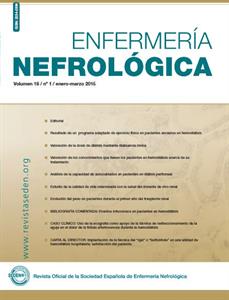Contenido del artículo principal
Resumen
Objetivo: Determinar si la forma de administración de la heparina durante el tratamiento con hemodiálisis influye en el estado de coagulación del sistema extracorpóreo.
Metodología: Estudio cuasiexperimental en 27 pacientes en Hemodiálisis crónica. Se establecen dos periodos de estudio. En el primero, la heparina prescrita se administra a través del acceso vascular y durante el segundo periodo, a través del botón arterial del sistema extracorpóreo.
Resultados: Se estudiaron 27 pacientes, siendo el 37% mujeres, y la edad media 68,63±17,44. El 63% de los pacientes realizaba Hemodiafiltración on line postdilucional. No hubo diferencias estadísticamente significativas en cuanto a la dosis y parámetros de diálisis, el AV, el tratamiento anticoagulante ni la técnica de HD.
En cuanto al estado de coagulación, si agrupamos por puntuación mayor o menor de 5, en el primer periodo, el porcentaje medio agrupado inferior a 5 puntos alcanza el 94,09% mientras que en el segundo periodo es de 97,1%, lo que sí resulta estadísticamente significativo (p=0,035).
Conclusiones: Según nuestro estudio, administrar la Heparina sódica en el circuito extracorpóreo mejora el estado final de coagulación del sistema, lo que supone una menor pérdida sanguínea para el paciente.
Metodología: Estudio cuasiexperimental en 27 pacientes en Hemodiálisis crónica. Se establecen dos periodos de estudio. En el primero, la heparina prescrita se administra a través del acceso vascular y durante el segundo periodo, a través del botón arterial del sistema extracorpóreo.
Resultados: Se estudiaron 27 pacientes, siendo el 37% mujeres, y la edad media 68,63±17,44. El 63% de los pacientes realizaba Hemodiafiltración on line postdilucional. No hubo diferencias estadísticamente significativas en cuanto a la dosis y parámetros de diálisis, el AV, el tratamiento anticoagulante ni la técnica de HD.
En cuanto al estado de coagulación, si agrupamos por puntuación mayor o menor de 5, en el primer periodo, el porcentaje medio agrupado inferior a 5 puntos alcanza el 94,09% mientras que en el segundo periodo es de 97,1%, lo que sí resulta estadísticamente significativo (p=0,035).
Conclusiones: Según nuestro estudio, administrar la Heparina sódica en el circuito extracorpóreo mejora el estado final de coagulación del sistema, lo que supone una menor pérdida sanguínea para el paciente.
Palabras clave
Hemodiálisis
Heparina sódica
Anticoagulación.
Detalles del artículo
Licencia
Aviso de derechos de autor/a
© Los autores ceden de forma no exclusiva los derechos de explotación de los trabajos publicados y consiente en que su uso y distribución se realice con la Licencia Creative Commons Atribución - No comercial 4.0 Internacional (CC BY-NC 4.0). Puede consultar desde aquí la versión informativa y el texto legal de la licencia. Esta circunstancia ha de hacerse constar expresamente de esta forma cuando sea necesario.
Cómo citar
1.
Pelayo Alonso R, Cuadrado Mantecón ME, Martínez Álvarez P, Rojo Tordable M, Ibarguren Rodríguez E, Reyero López M. Heparinización directa del paciente frente a heparinización del circuito extracorpóreo en hemodiálisis: estudio comparativo. Enferm Nefrol [Internet]. 2015 [consultado 16 Dic 2025];18(1):[aprox. 5 p.]. Disponible en: https://www.enfermerianefrologica.com/revista/article/view/4038




